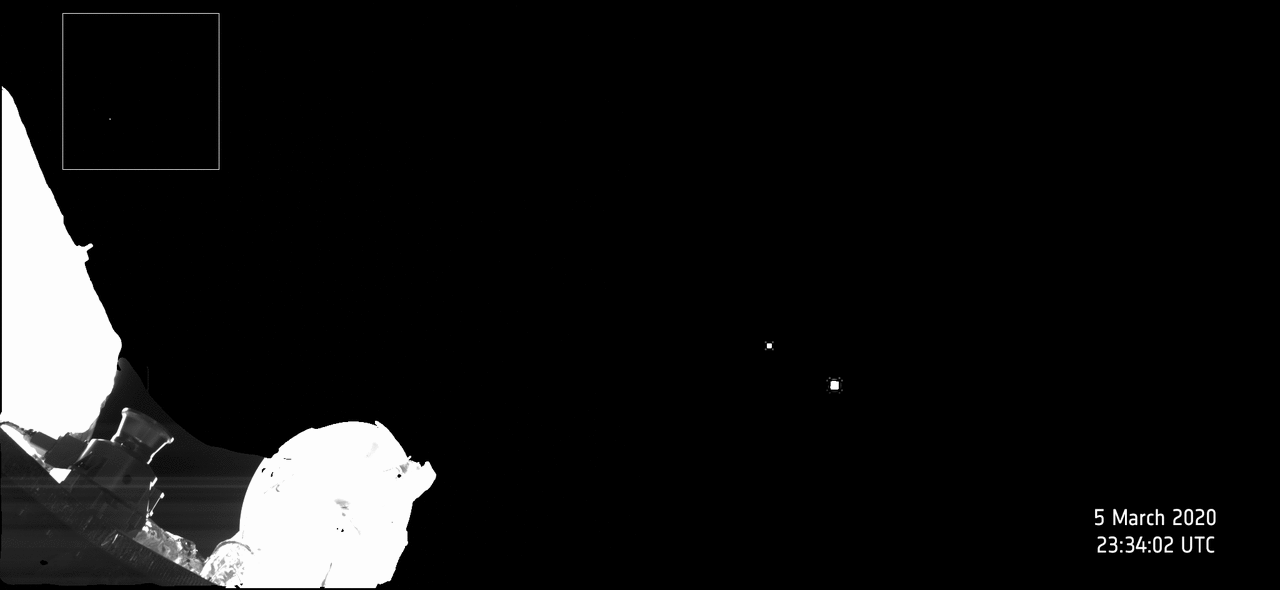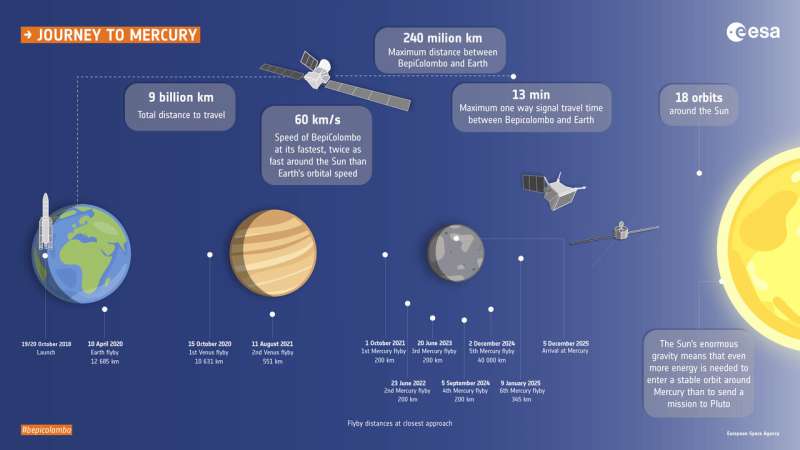ESA to conduct BepiColombo flyby amid coronavirus crisis

Controllers at ESA's mission control center are preparing for a gravity-assist flyby of the European-Japanese Mercury explorer BepiColombo. The maneuver, which will see the mission adjust its trajectory by harnessing Earth's gravitational pull as it swings past the planet, will be performed amid restrictions ESA has implemented in response to the coronavirus pandemic.
BepiColombo, launched in October 2018, is currently orbiting the sun at a similar distance as Earth. On 10 April, at about 06:25 am (CEST), the spacecraft will approach Earth at the distance of only 12 700 km, which is less than half the altitude of Europe's Galileo navigational satellites. The maneuver will slow down the BepiColombo spacecraft and bend its trajectory towards the center of the solar system, thus tightening its orbit around the sun.
"This is the last time we will see BepiColombo from Earth," says Joe Zender, BepiColombo Deputy Project Scientist at ESA. "After that it will head deeper into the inner solar system."
Mission scientists plan to use the flyby to test some of the 11 instruments aboard ESA's Mercury Planetary Orbiter (MPO), one of the European components of the mission, which travels to the innermost planet of the solar system together with the Mercury Magnetospheric Orbiter (Mio) of the Japan Aerospace Exploration Agency (JAXA). The two science orbiters are stacked on top of the ESA-made Mercury Transfer Module (MTM), with Mio sitting atop hidden behind a protective sunshield. The transfer module obscures the view of some of the MPO instruments, but the scientists expect to be able to obtain data from eight of the 11 science payloads. Mio's view is mostly blocked by the sunshield, but some of its sensors will also be switched on during the flyby.
The operation, however, will be performed with limited personnel at ESA's European Space Operations center (ESOC) in Darmstadt, Germany, where engineers will have to comply with social distancing rules presently in place all over Europe as a response to the coronavirus pandemic.
"The Earth swing-by is a phase where we need daily contact with the spacecraft," says Elsa Montagnon, BepiColombo Spacecraft Operations Manager at ESA. "This is something that we cannot postpone. The spacecraft will swing by Earth independently in any case."
The coronavirus threat forces the team to work with minimal face to face interaction while ensuring all steps in the process are properly covered.
"During the critical two weeks prior to the closest approach, we need to upload safety commands to prepare the spacecraft for unexpected problems," says Christoph Steiger, BepiColombo Deputy Spacecraft Operations Manager. "For example, we need to prepare the transfer module for the 34 minute-long eclipse when its solar panels will not be exposed to sunlight to prevent battery discharge."
Operations can still be conducted as planned, he adds, but will require more effort and attention than in a normal situation.
ESA's BepiColombo Project Scientist Johannes Benkhoff hopes that, despite the challenging circumstances, the science teams will be able to switch on the MPO instruments to test and calibrate them.
"For example, the PHEBUS spectroscope will use the moon as a calibration target to then produce better data once at Mercury," says Johannes. "We also want to make some measurements of the solar wind and its interaction with Earth's magnetic field. The main purpose of having the instruments on at this stage, however, is testing and calibration. If we can use the data for some scientific investigation, it will be a bonus."
BepiColombo also carries three GoPro-style 'selfie' cameras, mounted on the transfer module, that will be taking photographs as the spacecraft approaches Earth. The scientists activated the cameras in early March and took a few snaps of the Earth-moon system as viewed by BepiColombo from its position hurtling towards the Earth.
"We will see the Earth approaching and getting bigger," says Joe. "When it reaches the nearest point, we will take a few images, and then we are planning to capture a whole sequence of photographs over several hours looking at the Earth-moon system as it gets smaller and smaller until we lose it completely."
Frank Budnik, ESA's BepiColombo Flight Dynamics manager, adds: "As long as all team members are healthy and the spacecraft continues to perform nominally, everything can proceed as planned."
The Earth flyby on 10 April is only the first of nine gravity assist maneuvers awaiting BepiColombo during its 7-year journey to Mercury. In October, the spacecraft will perform the first of two flybys at Venus. The final six orbit-tightening maneuvers will use the gravity of BepiColombo's destination, Mercury.

BepiColombo will arrive at Mercury in late 2025. The science mission will commence three months later, after Mio and the MPO separate from the transfer module and enter their respective target orbits. Together, the two orbiters will help scientists shed light on the evolution of Mercury, the least explored of the four rocky planets in the solar system and the one closest to the sun.
Learning about Mercury's composition, the geological processes on its surface and the environment around it will help scientists answer some fundamental questions not only about Mercury, but also about the formation and evolution of the entire solar system.
Amateur astronomers equipped with small telescopes will be able to observe BepiColombo during the flyby, if located in southern latitudes. Observers in southern Europe might be able to spot the spacecraft briefly. The best view, however, will only be possible from the southern hemisphere.
Provided by European Space Agency





















